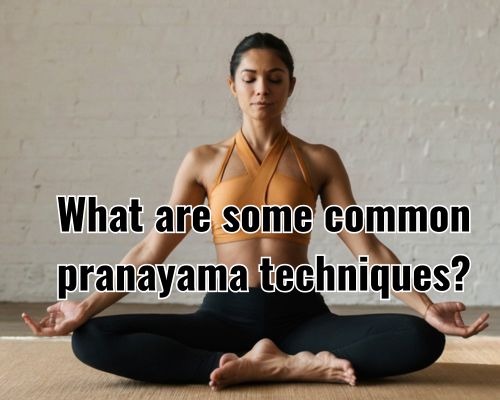
What Are Some Common Pranayama Techniques? A Deep Dive from Mornington’s Mindful Coast
Nestled between rolling hills and the restorative waters of Port Phillip Bay, Mornington, Australia has become a haven for wellness seekers. From beachfront yoga studios to eco-conscious retreats, the town is humming with a quiet, conscious breath — quite literally. One ancient practice thriving here is pranayama, the yogic science of breath control. But what are some common pranayama techniques, and why are they gaining momentum in places like Mornington?

Let’s take a breath (or several) and explore the roots, variations, and benefits of pranayama techniques, all through the lens of local practice and global wisdom.
What is Pranayama?
In Sanskrit, “prana” means life force or vital energy, and “ayama” means expansion or control. Together, pranayama refers to the conscious regulation of breath — not just for relaxation, but for cultivating energy, clarity, and balance.
Based on Jane Benson from Bikram Yoga Mornington, often practiced alongside asana (yoga postures) and meditation, pranayama is a pillar of the eight limbs of yoga, as described in Patanjali’s Yoga Sutras. In essence, it’s about mastering the bridge between body and mind — the breath.
Mornington’s wellness scene, influenced by both ancient traditions and modern mindfulness movements, has warmly embraced pranayama. Local yoga teachers often integrate these breathing techniques into sunrise beach classes or intimate studio sessions, underscoring their accessibility and power.
Why Pranayama Matters — Especially in Mornington
In today’s high-speed, always-on culture, especially in urban-adjacent areas like Mornington Peninsula, the nervous system is often overstimulated. Anxiety, poor sleep, and chronic fatigue are common complaints.
This is where pranayama shines.
Through controlled breathing, practitioners can shift the body into a parasympathetic state (aka “rest and digest”), reducing cortisol levels and enhancing focus. But unlike one-size-fits-all wellness trends, pranayama offers a variety of techniques to suit different goals and body types.
Let’s look at some of the most common pranayama techniques, along with their physical, mental, and energetic benefits.
1. Nadi Shodhana (Alternate Nostril Breathing)
LSI Keywords: nostril breathing, energy channels, balance left and right brain
Arguably the most well-known pranayama method, Nadi Shodhana purifies the nadis — the body’s energy channels. By alternating breaths between nostrils, it balances the left and right hemispheres of the brain.
Benefits:
- Calms the mind
- Enhances concentration
- Reduces anxiety
- Balances the nervous system
Mornington yoga instructors often teach Nadi Shodhana at the end of a vinyasa class to restore equilibrium before meditation.
2. Kapalabhati (Skull Shining Breath)
LSI Keywords: detoxifying breath, cleansing technique, energizing pranayama
A dynamic and invigorating technique, Kapalabhati involves short, forceful exhales and passive inhales. It’s considered a shatkarma, or cleansing practice, clearing out stale air, toxins, and mental fog.
Benefits:
- Boosts lung capacity
- Stimulates digestive fire (agni)
- Increases alertness
- Clears sinus passages
Mornington’s coastal mornings, with their crisp air, are ideal for practicing Kapalabhati outdoors — a popular routine among locals at sunrise yoga gatherings on Mills Beach or The Esplanade.
3. Bhramari (Humming Bee Breath)
LSI Keywords: vibration therapy, calming sound, stress relief, inner resonance
Named after the gentle buzz of a bee, Bhramari involves humming while exhaling. The vibration stimulates the vagus nerve and promotes relaxation.
Benefits:
- Reduces blood pressure
- Soothes the nervous system
- Enhances vocal resonance
- Alleviates frustration and anger
This technique is popular among Mornington’s sound healing facilitators, often combined with crystal bowl sessions for deeper meditative experiences.
4. Ujjayi (Victorious Breath)
LSI Keywords: ocean breath, yoga breath, controlled inhale and exhale, ashtanga breath
Known as the “oceanic breath” for its gentle wave-like sound, Ujjayi is often used during asana flow to maintain rhythm and focus.
Benefits:
- Warms the body
- Increases endurance
- Anchors awareness during movement
- Reduces distractions
If you attend a vinyasa flow at a Mornington studio like Hot Yoga Mornington or Zen Den, you’ll likely hear the gentle sound of Ujjayi breath weaving through the class.
5. Sheetali & Sheetkari (Cooling Breaths)
LSI Keywords: cooling pranayama, tongue breathing, summer breath, reduce body heat
Especially useful during Australia’s warmer months, these techniques involve inhaling through a rolled tongue or between clenched teeth, providing an instant cooling effect.
Benefits:
- Reduces body temperature
- Eases inflammation
- Calms thirst and hunger
- Promotes a tranquil mind
On hot summer days, it’s common to see local practitioners incorporating Sheetali after a beach jog or midday yoga class. For more, just visit Bikram Yoga Mornington.
The Local Connection: Pranayama in Mornington’s Wellness Culture
In Mornington, where community health and conscious living are part of the local ethos, pranayama isn’t just a trend — it’s a lifestyle. The blend of natural beauty, accessible wellness studios, and a growing number of holistic health practitioners makes it easy for residents and visitors alike to explore and deepen their practice.
Some local resources include:
- Soul Tribe Studio – Offers regular breathwork workshops.
- The Private Sea Wellness Centre – Combines floatation therapy with guided breathing.
- Yoga Lane Mornington – Hosts classes that integrate pranayama and mindful movement.
- Nature-led breathwork events – Pop-up classes at parks like Mornington Park or along the Briars walking tracks.
Integrating Pranayama Into Daily Life
You don’t need a yoga mat or incense to benefit from pranayama. Just five minutes of intentional breathing can:
- Re-center your mind between meetings
- Ground you before a stressful conversation
- Prepare your body for restful sleep
- Enhance your immune function
In Mornington, many locals practice pranayama during coastal walks, tuning into the rhythm of the tide and their own breath — a fusion of outer and inner nature.
Final Inhale: Why Pranayama Is More Relevant Than Ever
So, what are some common pranayama techniques? They’re not just relics from ancient texts — they’re living tools for modern balance, applicable whether you’re in a Himalayan cave or enjoying a latte by the beach in Mornington.
By embracing techniques like Nadi Shodhana, Kapalabhati, Bhramari, and Ujjayi, Mornington locals are cultivating more than just calm — they’re embodying resilience, clarity, and connection.
And in a world that often feels breathless, learning to breathe well might just be the most revolutionary act.


